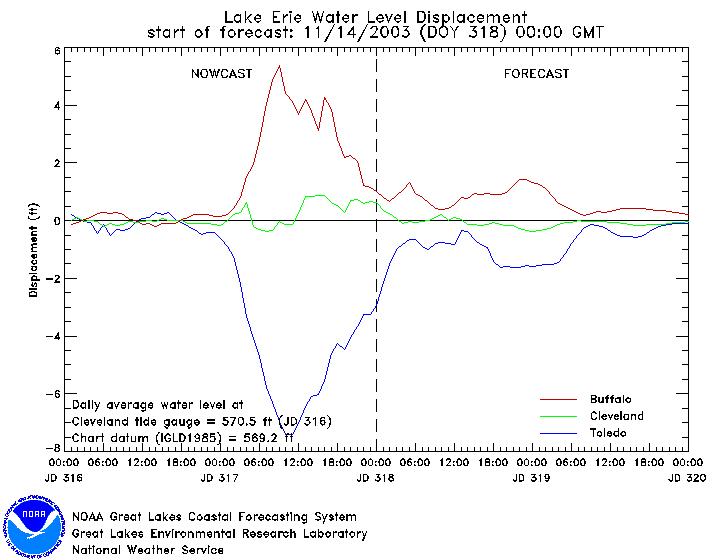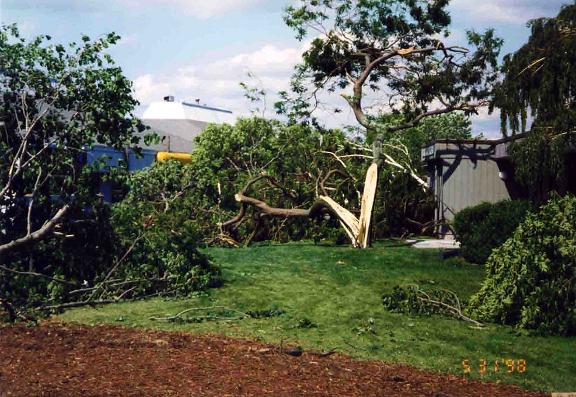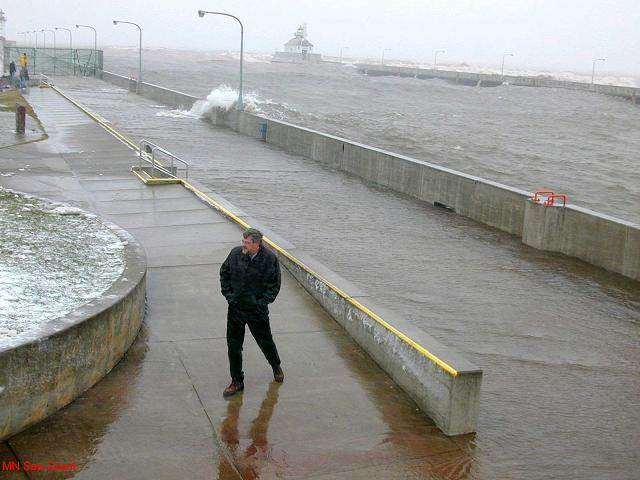SIECHES ON THE GREAT LAKES
The water levels of the Great Lakes are a greatly talked about subject among many. The Great Lakes are accustom to three major types of water level fluctuation; seasonal, long-term, and short-term. Seasonal fluctuations are generally expressed for one year and consist of the changing four seasons. Long-term levels occur over a certain period of time usually ranging from a few to many consecutive years in time. Seasonal and long-term changes generally show the amount of water in the Great Lakes through the hydrologic cycle. Seasonal and long-term fluctuations of lake levels are mostly talked about among boaters, fishermen, marina owners, plus many others that are associated with the Great Lakes in one way or another. Short-term fluctuations are rarely talked about and range from minutes to hours to days (Gauthier and Manninen,1999; US Army Corps of Engineers and Great Lakes Commission, 1999).
Short-term fluctuations that often occur on the Great Lakes are wind set-up or storm surge, and a phenomenon known as a seiche. A storm surge or wind set-up consists of high sustained winds from one direction that push the water level up at one end of the lake and make the level drop by a corresponding amount at the opposite end.
 (Courtesy of Great Lakes Commission, used with permission)
(Courtesy of Great Lakes Commission, used with permission)
This is a good illustration of wind set-up. Storm surges increase in height as the wind increases, resulting in surges as high as eight feet on the Great Lakes that are often sudden and unexpected (Clark, 2005; Wittman 2005).
When combined with dramatic changes in atmospheric pressure or a sudden drop in the wind speed, storm surges soon produce a seiche.
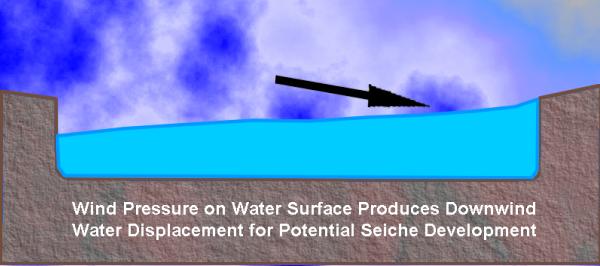 (Courtesy of Keith C. Heidorn, PhD � The Weather Doctor, used with
permission)
(Courtesy of Keith C. Heidorn, PhD � The Weather Doctor, used with
permission)
A seiche has to occur in an enclosed body of water such as a lake, bay or gulf. A seiche, a French word meaning �to sway back and forth�, is a standing wave that oscillates in a lake as a result of seismic or atmospheric disturbances creating huge fluctuations of water levels in just moments. The standing waves slosh back and forth between shores of the lake basin, often referred as tide-like changes of the Great Lakes, by many. Most seiches on the Great Lakes are results of atmospheric disturbances and a cease in wind, not seismic activity or huge tidal forces ( Heidorn 2004; Wittman 2005).
Many people think there are tides in the Great Lakes and thus result in the huge changes of water levels. True tides are changes in water levels caused by the gravitational forces of the Sun and Moon. The U.S. Army Corps of Engineers, the National Oceanic and Atmospheric Administration (NOAA), and the National Ocean Service (NOS) have proved that the spring tide, the largest tide on the Great Lakes, is less than 2 inches. The minor tidal changes on the Great Lakes are oblivious compared to the much greater fluctuations of the lakes caused by changes in wind and atmospheric pressure. As a result, the Great Lakes are considered to be a non-tidal water system (NOAA 2005).
The concepts of storm surge and seiche may sound very similar to many people, leaving many confused about what truly happens when. A big difference between storm surge and a seiche on the Great Lakes is the addition of significant changes in atmospheric pressure or quick-moving squall fronts, generating the oscillation of the water.
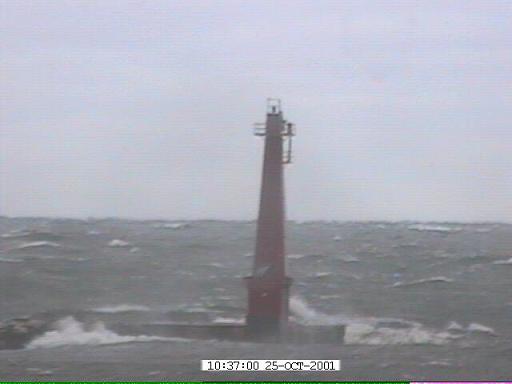
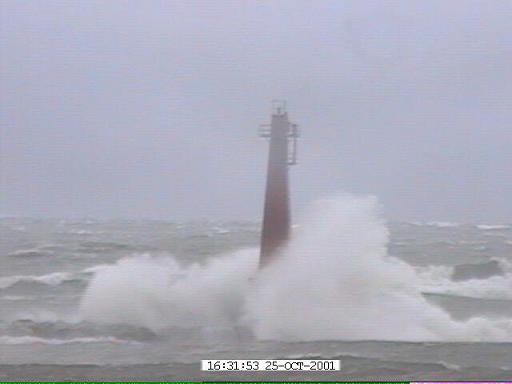
Images from the Muskegon Web Cam � Courtesy of NOAA-Great Lakes Environmental Research Laboratory, used with permission)
These two photos of the Muskegon South Lighthouse demonstrate how atmospheric disturbances can change the conditions and lake levels of Lake Michigan. These two photos were taken 6 hours apart on October 21, 2001, the first image showing the normal lake conditions and the second image 6 hours later representing a seiche at Muskegon.
Storm surges are the most common type of short-term fluctuations on the Great Lakes as quite often strong storm winds blow across the lakes and pile up water on the downwind shore of the lake, resulting in wind set-up. On the opposing upwind shore, the storm surge lowers the water the exact amount that has risen at the downwind shore, resulting in a wind set-down.
A seiche is exactly the same as storm surge except the surface water oscillates by sloshing between opposing shores within the lake basin, decreasing in height with each rocking back and forth until it reaches equilibrium.
Storm surge and seiches come about suddenly and unexpectedly, damaging shorelines, sinking ships, leaving ships high and dry, and causing flooding (Clark, 2005; Wittman 2005).
Records show that a seiche has occurred on all five of the Great Lakes.
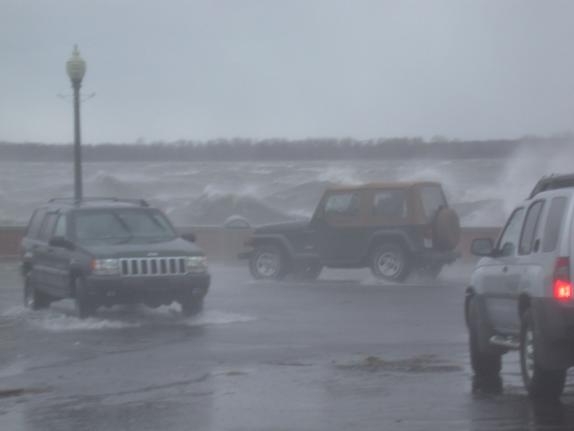
This is a photo taken at Erie, PA on November 13, 2003, representing the extremely high water levels and storm surge that soon turned into a seiche. Tsunami waves and seiche waves are often categorized together, but with two major differences. Seiche waves are much smaller than tsunami waves and are caused by wind and atmospheric pressure changes, while tsunami waves are much larger and caused by earthquakes. Lake Erie is known for producing the most and largest seiches of the five lakes, due to being the shallowest Great Lake. The southwest winds of Lake Erie frequently assemble seiches that affect the large cities of Toledo, OH and Buffalo, NY on opposite shores of Lake Erie.
(Courtesy of NOAA-Great Lakes Environmental Research Laboratory, used with permission)
This graph is a great example of the water fluctuations on Lake Erie from November 14, 2003. The graph compares the cities of Toledo and Buffalo during a seiche, as mentioned above.
(Courtesy of NOAA-NOS-CO-OPS- Great Lakes Environmental Research Laboratory, used with permission)
These two graphs compare the water levels of two specific areas from November 11-13, 2003. You can see in Buffalo, NY, the water level rose rapidly and then slowly started to decrease back to normal. In comparison, the Fermi Power Plant, MI graph represents how the water level dropped quite quickly and then after a few hours it started to incline back to its original position (Alexander 2005).
As early as 1689, Baron La Hontan noted tide-like variations or seiches on his journeys of Lake Michigan. He noted that Green Bay would fluctuate three feet everyday and that the Straits of Mackinac had unusually strong currents. In 1721, French Jesuit Pierre de Charlevoix noted the water levels would change while traveling on Lake Ontario. Charlevoix noticed the water level fluctuated on the shoreline exposing and burying rocks daily. Another early explorer traveling the lakes, Henry Rowe Schoolcraft, in 1721, observed and documented his findings of water levels on the Great Lakes. He noted in Green Bay, while using a stake driven into the shoreline, that the water levels on Green Bay actually did fluctuate but was not exactly sure why or how (Dennis 2003. pgs. 267-268).
Most seiches on the Great Lakes are small and not very destructive, dangerous or life threatening to people on land. Many seiches force ships to wait or dock in a harbor until the seiche has finished and it is safe to depart. Strong rip currents often accompany a seiche, causing very dangerous water fluctuations and movements of abnormal currents. Occasionally, a destructive and even deadly seiche attacks the shores of the Great Lakes. Many of the deadliest seiches have occurred on Lake Michigan with a few somewhat large and destructive seiches taking place on Lakes Superior, Huron and Erie (Dennis 2003. pgs. 22-23).
On July 4, 1929, over 45,000 people gathered in Grand Haven, MI to partake in holiday events at Grand Haven State Park, on the eastern shore of Lake Michigan. A series of seiches attacked the Grand Haven shoreline after an early morning storm. The storm produced a seiche that generated into high winds and 20-foot waves. The seiche completely buried the Grand Haven pier sweeping people off and left helpless, while strong rip currents carried several more away from the beach. The deadly seiche of 1929 was responsible for taking ten lives to the mighty and fierce Lake Michigan (Alexander 2005).
Nine years later, on July 13, 1938, another deadly seiche came about on the eastern shore of Lake Michigan, just 20 miles south of Grand Haven, in Holland, MI. It was a beautiful calm day on the beach at the Holland State Park. Later that day, a huge amount of water that was piled on the Wisconsin shore two days earlier due to an east wind, returned to Holland in the form of a seiche. The calm seas soon turned into monstrous ten-foot edge waves with fierce rip currents that swept people from the beach, pier and boats. The seiche of 1938 claimed another five lives on the eastern shore of Lake Michigan (The Joint Archives of Holland 2001).
On June 26, 1954, the southern basin of Lake Michigan experienced a seiche in numerous locations, including the entire Illinois shoreline. The seiche was caused by a squall line that started in Michigan City, IN. The seiche continued to build in size along the Illinois shore.
(Courtesy of Illinois State Geological Survey-Bob Bauer, used with permission)
This diagram illustrates how the 1954 seiche formed and what areas were affected. Ten-foot waves struck North Avenue pier in downtown Chicago, IL. Fishermen were swept off the pier with many being rescued. Consequently, a Lake Michigan seiche yet again took the lives of eight people (Bauer 2005; Haas 2005). Chicago also has experienced such sudden and deadly waves (Haas 2005)
�A derecho, a widespread and long lived windstorm that is associated with a band of rapidly moving showers or thunderstorms, is yet another cause of a seiche� (NOAA 2005). In both 1995 and 1998, a fierce derecho invaded the Great Lakes region. On July 13, 1995 a derecho created a seiche on Lakes Superior, Huron and Erie. Extremely high wind gusts and changes in barometric pressure occurred on Lake Huron, the ingredients for a seiche.
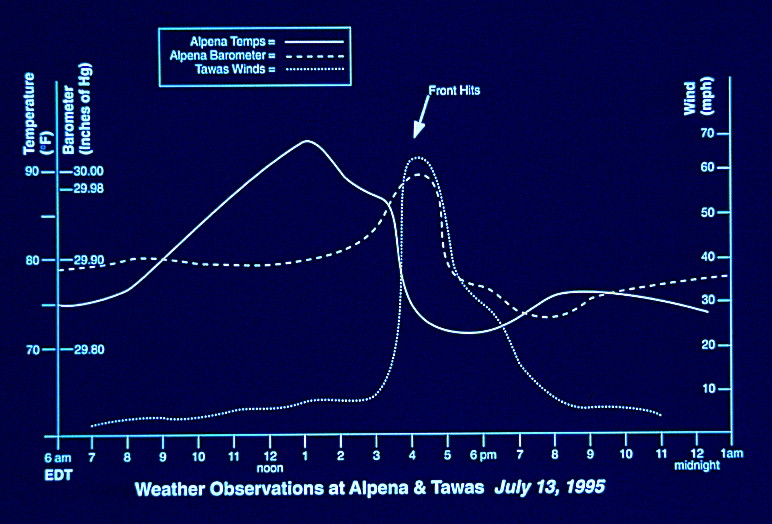
(Courtesy of NOAA-Great Lakes Environmental Research Laboratory, used with permission)
This graph displays the wind speed at Tawas, the temperature and barometric pressure at Alpena, on July 13, 1995 near Lake Huron during the seiche. The seiche also produced water level changes on Lake Huron and Lake Erie, causing boats to capsize and rescues to be conducted.

(Courtesy of NOAA-Great Lakes Environmental Research Laboratory, used with permission)
This graph is an excellent example showing how quick the water levels can change within minutes and even hours at specific locations during a seiche (NOAA 1995).
On May 31, 1998, a destructive and devastating derecho hit the eastern shore of Lake Michigan between Ludington and Holland, with wind gusts over 100 mph and huge seiches. Inland, near Grand Rapids, wind gusts were reported as much as 130 mph. This line of winds created havoc on much of West Michigan, which was declared a Federal Disaster Area. Boats were destroyed, trees were annihilated, and power outages lasted for weeks.
(Courtesy of Ann Selbig, used with permission)
This photo displays just a minimal amount of tree damage at Chinook Pier in Grand Haven, MI (NOAA 1998).
A seiche left many boats, in Grand Haven, MI, dangling in the air with just their dock lines holding them in their slip. �There was a huge gust, you could feel the pressure change, and all of a sudden the water rushed out and there we were lying in bed, dangling by a few scrawny dock lines�, explained Capt. Chip Klein of Hit Man Charters. �Many of the dock lines snapped due to the massive amount of weight they were holding�, said Klein. (Klein 2005).
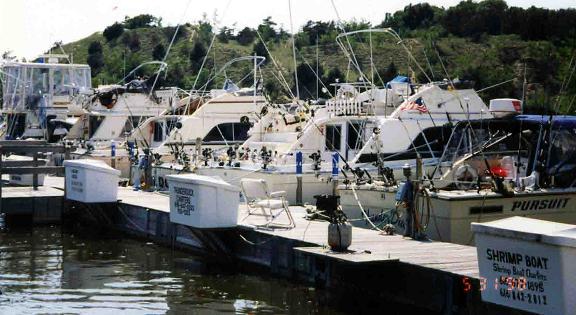
This photo illustrates the amount of damage to charter boats at Chinook Pier in Grand Haven, MI. You can see the canvas tops are torn off; outriggers are bent or missing, and rods and reels are gone.The Stephen M. Asher tug boat, fell victim to a seiche on the morning of May 31, 1998 in Muskegon County. The tug boat sank in White Lake Channel as the water rushed back out from White Lake into Lake Michigan, causing the tug to roll on its side and sink. The crew survived the seiche and no one was injured as they all reached land safely (NOAA 1998).
Severe and deadly seiche events are rare on the Great Lakes. Storm surge, edge waves, rip currents, and seiches are often associated with strong wind, derechos, and thunderstorms. This is the time when seiches are talked about and most likely to generate damage, flooding, or even drowning.
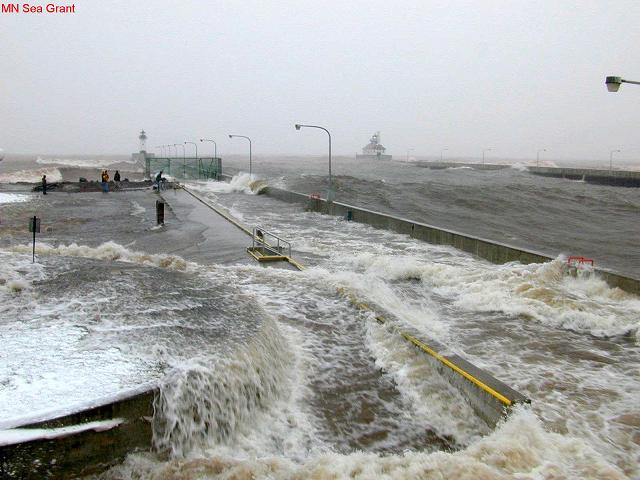
(Courtesy of Minnesota Sea Grant-NOAA-Great Lakes Environmental Research Laboratory, used with permission)
These two photos are just another example of how dangerous a seiche can be. These two photos were taken on November 27, 2001, just minutes apart, at Canal Park in Duluth, MN. The first photo is showing storm surge and a man on the Canal Park path. The second photo, taken just minutes later, represents how quick and fierce a seiche can occur without warning.
Seiches occur on the Great Lakes everyday, sometimes hazardous, but mostly seiches go unnoticed as the lake is calm. People have always wondered why, when the lake is flat calm, there are still waves rolling onto the shorelines. This has to do with an assortment of atmospheric pressures that include rip currents, currents, seiches, and storm surges occurring quite possibly hundreds of miles away. Surface water on the Great Lakes can be moved hundreds of miles in just days. Take caution when in, near, or on a Great Lake and its tributaries. The Great Lakes are beautiful to most, hazardous to some, fierce and wicked to few. Take caution and respect the force and power of the mighty Great Lakes.
REFERENCES
Alexander, Jeff. 2005. Big Lake �tsunamis�. The Muskegon Chronicle, sections 1A and 4A. 2005, January 30.
Bauer, Bob. 2005. Sudden, Large Waves a Lake Michigan Danger. Illinois State Geological Survey. project..isgs.uiuc.edu/isgshome/seiche_info.htm
Clark, Gene. 2005. University of Wisconsin Sea Grant. Coastal Natural Hazards: Seiches and Storm Surges. project..seagrant.wisc.edu/coastalhazards/default.aspx?tabid=426
Dennis, Jerry. 2003. The Living Great Lakes. New York. St. Martin�s Press, 2003.
Gauthier, Roger and Manninen, Christine. 1999. Living with the Lakes. US Army Corps of Engineers and Great Lakes Commission, 1999. pgs. 15-17.
Haas, George. 2005. Chicago also has Experience with Sudden Deadly Wave. 2005, January 31 Daily Southtown.
Heidorn, Keith C. 2004. Sloshing the Lakes: The Seiche. The Weather Doctor�s Weather Almanac, June 2004. project..islandnet.com/~see/weather/almanac/arc2004/alm04jun.htm
The Joint Archives of Holland: 2001. JA Quarterly-Summer 2001. Fatal Wave: The Seiche. project..hope.edu/jointarchives/quarter/sum01/seiche.html
Klein, Chip. 2005. Personal Interview. 2005, 15 April.
NOAA-National Ocean Service, Are there tides in the Great Lakes? CO-OPS. project..co-ops.nos.noaa.gov/faq2.html
NOAA. 2005. Storm Prediction Center, project..spc.noaa.gov/misc/AbtDerechos/#definition
NOAA. 1995. Storm Prediction Center, July 1995 Derecho Series. The Right Turn Derecho.
project..spc.noaa.gov/misc/AbtDerechos/casepages/jul1995derechopage.htm#2nd1995
NOAA. 1998. National Climatic Data Center, Event Record Details. project.4.ncdc.noaa.gov/cgi-win/wwcgi.dll?wwevent~ShowEvent~336487
Wittman 2005. University of Wisconsin Sea Grant. What is a Seiche? project..seagrant.wisc.edu/communications/lakelevels/seiche.htm
Page created by Jonathan Selbig, a GEO 333 student
This material has been compiled for educational use only, and may not be reproduced without permission. One copy may be printed for personal use. Please contact Randall Schaetzl (soils@msu.edu) for more information or permissions.

